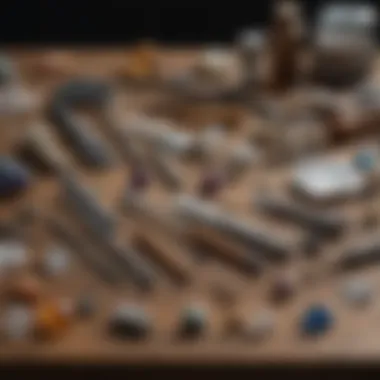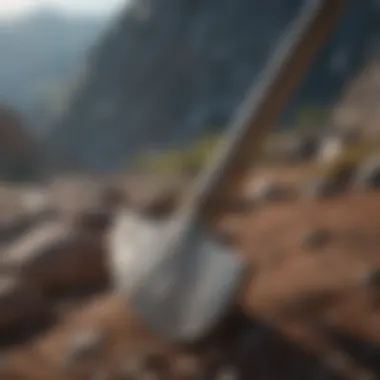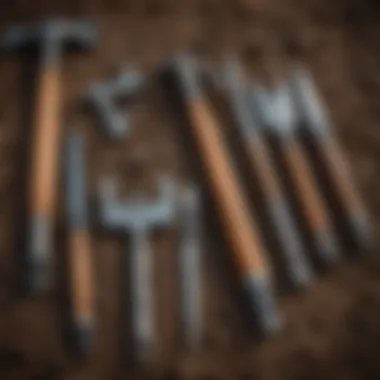Essential Crystal Digging Tools for Enthusiasts and Collectors


Intro
In the world of crystal digging, enthusiasts engage not just in a hobby but a fascinating blend of science, patience, and artistry. Whether you’re a novice or have years of experience, understanding the fundamental tools necessary for effective crystal excavation is critical for success. This guide seeks to unravel the essential instruments that empower collectors to unearth nature's hidden gems.
The tools available vary significantly in capability and application. Understanding what each tool is designed for will not only elevate your skills but also enhance your overall experience in the field. From identifying ideal instruments to knowing how to maintain them, every aspect plays a vital role in becoming an accomplished collector. Let's delve into the various aspects that comprise crystal digging tools, beginning with how to identify the rocks and fossils you may encounter.
Rock and Fossil Identification
Identification is perhaps the most critical skill for any collector. You need to know what you are looking for. This understanding will shape your project outcomes significantly.
Types of Rocks and Fossils
Rocks are generally classified into three categories:
- Igneous rocks: Formed from cooled magma or lava. Examples include granite and basalt.
- Sedimentary rocks: Created by sediment compaction over time. Sandstone and limestone fall into this category.
- Metamorphic rocks: These are formed through the alteration of existing rocks due to heat or pressure, with examples being schist and marble.
Fossils, on the other hand, come in various forms including imprints, bones, and preserved remains. Familiar species can include trilobites and ammonites. Understanding these classifications enables proper identification and value assessment.
Characteristics to Look For
When identifying rocks and fossils, some particular characteristics warrant attention:
- Color: It can often provide insights into the composition.
- Texture: Surface texture gives clues about formation methods.
- Habit: The shape and general expression of rocks also play a vital role in identification.
- Location: Gathering information about the geographical context can enhance your understanding of what you find.
Tools for Identification
Several tools assist in the identification process:
- Hand lens: Enables close examination of textures and inclusions.
- Rock hammer: Useful for breaking rocks apart to view their inner characteristics.
- Field guidebooks: These serve as references that detail specific characteristics and backgrounds.
Identification sets the foundation for informed collecting. Knowledgeably navigating this part of the experience enriches both the acquisition and appreciation of your findings.
In summary, understanding rocks and fossils is paramount to successfully collecting. It involves knowing what you want and how to identify it. From here, we gain insight into collecting best practices and techniques that will prepare collectors for their expeditions.
Prologue to Crystal Digging Tools
The art of crystal collecting requires more than just passion; it demands the right set of tools. Each collector, whether novice or seasoned, needs to understand how equipment plays a critical role in the development of their experience. Using appropriate tools not only enhances efficiency but also ensures safety and maximizes potential finds.
In crystal digging, precise tools can make a significant difference. For example, having the right type of shovel can allow for easy access to different soil types, increasing the chances of uncovering rare specimens. Additionally, specific tools cater to varying depths and surface conditions, guiding access to underground treasures.
Furthermore, tool knowledge is paramount. A well-informed collector can distinguish between basic digging tools and advanced geological equipment. Different terrains and crystal types require distinct approaches, reinforcing the necessity of a comprehensive understanding of available tools.
Being equipped with the right tools fosters a productive digging experience and grants confidence in the field. Collectors can optimize their strategies based on terrain, whether working in soft soil or rocky environments. Each decision on tool selection directly impacts success in mining for crystals.
As we explore the specifics of various crystal digging tools, collectors will gain further insight into which instruments will best suit their needs. This guide, thus, functions not only as an overview of necessary equipment but also as a resource aimed to elevate the collector's experience.
"Understanding your tools enhances not only your pleasure but also your success in the field of crystal collecting."
This section aims to establish the groundworks needed for efficient digging, emphasizing that having the right tools is a pivotal aspect of any collecting endeavor.
Significance of Appropriate Tools
The role of appropriate tools in crystal digging cannot be emphasized enough. Choosing the right tools shapes the effectiveness and efficiency of collecting efforts. In the field of crystal collecting, these tools determine not only the success rate of artifact recovery but also influence the safety and enjoyment of collectors during the process.


First and foremost, using the correct tools minimizes the risk of damage to the crystals. Precious stones and minerals can be brittle and sensitive to pressure. A gentle approach, supported by the right instruments, enhances the likelihood of unearthing intact specimens. Collectors who invest in suitable tools often find their yield increases, as many tools aid in precision. For example, a sifter can help collectors separate valuable gems from unwanted debris.
In a world where the demand for geological finds is rising, having the right equipment promotes deeper exploration initiatives. Tools like pickaxes or diamond core drills extend the feasible depth and range of collection. A collector equipped with advanced tools navigates complex terrains with far less struggle than those relying only on basic implements.
"The right tools can turn a potential struggle into a streamlined success, especially when collecting in challenging environments."
Moreover, appropriate tools enhance the educational aspect of crystal digging. Familiarity with geological tools enriches a collector's understanding of rock formations, crystal types, and excavation methods. Experiences in the field can develop further knowledge on geological processes, crystal growth, and historical significance of finds. This connection between collector and environment underpins a more profound appreciation for the hobby.
Lastly, optimal tools must consider safety standards. As with any physical endeavor, crystal digging poses conditions that can be hazardous. Sturdy footwear, gloves, and head protection complement the key instruments, reduces injury risk. Knowledge of how to properly use all tools protects both the individual and their finds.
Essential Tools for Crystal Digging
Crystal digging requires the right set of tools to enhance the overall experience and maximize the chances of successful findings. Having essential digging tools is not just about convenience; it also ensures efficiency, safety, and effectiveness in excavating operations. This section addresses each specific tool while explaining their roles, benefits, and key considerations.
Shovels
Shovels are fundamental tools for any crystal collector. They are designed to move soil and debris quickly, making them essential when you need to clear a large area rapidly. There are various types of shovels, each suited for different digging requirements. Steel shovels offer strength and durability, while plastic options can reduce weight, helping in manual operations.
Using shovels effectively means knowing when and where to dig. A shovel is particularly useful in softer terrain, allowing you to remove top layers gently to access the crystals below. Always consider using one with a non-slip grip to avoid injuries during extended use.
Pickaxes
Pickaxes serve a unique purpose in crystalline excavation. The pointed end is ideal for breaking apart more challenging rocky surfaces popular among advanced collectors. With its design, a pickaxe allows for both digging and prying, which increases effectiveness. It is important to choose a pickaxe with a suitable weight; too heavy can cause fatigue while too light may not provide necessary force.
When targeting particular crystal types buried in solid rock, a pickaxe proves invaluable. The controlled pressure applied can help extract all essential components of mineral formations effectively without causing fractures.
Trowels
Trowels, although small, cater to specific tasks during the digging process. They are perfect for fine detailing after major excavation. Whether it is carefully uncovering crystals or smoothening the edges of your dig site, a trowel becomes indispensable. Collectors might often misuse bigger tools that can scuff soft deposits, but a trowel affords more precision.
Stainless steel trowels resist both rust and dirt, securing longevity in use. Furthermore, some trowels come with gradation markings for measuring depth when precise excavation is needed, enhancing accuracy in recovery.
Sifters
Sifters stand play an important role in separating larger rocks from your find. Essentially, they are crucial for efficiently identifying smaller crystals and mineral fragments. The design allows the earth to pass while retaining useful minerals, a real advantage in lightweight digging situations. The materials used for sifters can range from wood to plastic, though mesh sift formats have become more common in a modern context due to versatility.
For sophisticated collecting, adjusting the mesh size as per your target size can enhance efficiency. Indeed, particles trapped in sifter often tell a collectible's story, which is charming, and illustrating connections to rock types coming from deeper edges.
Drilling Tools
Drilling tools represent an efficient advancement in contemporary private excavation activities. While some crystal collectors rely on manual digging tools exclusively, core drillers provide an excellent way to examine layers without causing terrain damage. These gear types allow collectors to extract specific sections outputting minimal waste.
Investing in a quality drill often means balancing power with control. Electric options deliver potent perforation, whereas manual drillers afford user ambits in both skill and speed. Both variations have their rightful applications based on topography.
Safety Gear
Finally, the critical aspect of any collection experience is ensuring personal safety. The outdoor environment, especially around excavation lands, may conceal potential hazards from both landslides or sharp repeat debris. Collectors must equip themselves contemporary safety gear involving gloves, goggles, and durable shoes.
Additionally, helmets provide crucial head protection during dynamic activities especially where pickaxes are employed. Understandably, skimping on safety equipment can lead to injuries that might deter future recalling pursuits altogether. Awareness of fit, functionality, and placement drastically improve safe collection endeavors, and manifest respect for collective passion worn proudly from emergencies.
In review, crystal digging tools constitute the backbone of any collector's journey. From shovels to safety gear, each tool has its unique function and factor in gathering crystals effectively. By understanding the operational characteristics of these tools, enthusiasts can maximise their findings while decreasing unforeseen risks, ensuring a fruitful experience in their collecting endeavors.
Choosing the Right Tools Based on Terrain
Choosing the right tools based on the surrounding terrain is essential in crystal digging. The geological conditions greatly influence both the accessibility of potential finds and the type of tools necessary for effective extraction. Different terrains present unique challenges and requires specific tools that can enhance your collecting experience. By pursuing a tailored approach, collectors not only safeguard their efforts but also maximize efficiency during their excavations.


Soft Soil Applications
In areas with soft soil or loamy conditions, standard shovels and trowels are generally effective. These tools allow for easy penetration into the ground, and they can scoop up soil or gravel while minimizing disturbance to potential crystal locations. Using a trowel can be especially beneficial when digging close to fine mineral deposits. Furthermore, when digging in soft soil, it's advisable to use sifters as well. This equipment can quickly separate the desired crystals from loose particles, making retrieval cleaner and quicker. It is important to ensure that the tools used are lightweight to avoid fatigue, especially if you're spending extended periods digging.
Rocky Environments
Difficult terrain, such as rocky areas, presents several obstacles. In these environments, durability and strength matter most. Tools such as pickaxes and geological hammers become indispensable. A pickaxe allows you to break apart stubborn rock formations, while a geological hammer provides greater accuracy when hitting specific spots. Both tools prevent surface damage to the desired formations. Collectors should be vigilant about the locations they choose, often digging carefully in the spaces between rocks where minerals might be partially revealed.
It's important to remember the following tips:
- Look for signs of mineralization in cracks and crevices.
- Avoid using excessive force, as aggression can lead to damaging the crystals.
- Know nearby surrounding safety regulations in rock excavations to prevent legal issues.
Wetland Areas
Wetland areas can pose unique challenges due to their moisture and sometimes muddy conditions. Here, using appropriate tools becomes crucial. Modified shovel designs and non-slip trowels are invaluable when digging through water-logged environments. It helps to have tools with longer handles to maintain distance from mud if necessary. Additionally, consider bringing along knee boots for comfort and safety. Sifters also work remarkably well because they allow liquids to run off while retaining heavier crystals.
Collecting in wetlands inspires discovery but requires careful navigation to protect both yourself and the environment.
Remember that respecting the local ecosystem is vital. Always fill any holes you dig to return the site to its natural state.
Observing all these distinct traits allows for a more rewarding collection experience while benefitting the hobby overall.
Advanced Tools for Experienced Collectors
The section focuses on advanced tools, crucial for anyone looking to enhance their crystal-digging endeavors. While beginners may rely on basic tools like shovels or trowels, experienced collectors must consider more sophisticated equipment to ensure efficient and effective collection. Advanced tools allow for precision and often reduce the physical strain of digging through tough geological structures. The implications of these tools reach far beyond convenience; they have the potential to uncover specimens that are otherwise neglected.
Diamond Core Drills
Diamond core drills represent an advanced avenue for collectors. They are designed with a diamond-encrusted bit that efficiently penetrates solid rock. One significant benefit is the samples they yield, which are typically cylindrical cores of material. This method reduces damage to the collected specimens, ensuring that delicate formations remain intact. Unlike traditional drilling methods, diamond core drills allow for a clean cut, facilitating access to layers of geology that may otherwise be hard to explore.
Choosing the Right Size
When selecting a diamond core drill, size matters. Prior to usage, assess turbulence in the material. Larger diameter bits extract more rock and can penetrate harder layers, while smaller ones give more control in fragile environments.
Maximum Safety
Due to its heavy-duty nature, the equipment can pose risks if not handled properly. Always don appropriate safety gear, especially protective gloves and goggles. Often, the best outcome is achieved when two operators work on a difficult job to ensure safety and overseen results.
Geological Hammers
Geological hammers are indispensable in any seasoned collector's toolkit. Their value lies not only in straightforward applications but also in their versatile designs. A geological hammer often features a flat side for breaking rocks and a pointed end for chipping away at surfaces.
Choosing the Suitable Hammer
The weight should reflect the individual user's capabilities and task demands. A lighter hammer is suitable for more delicate work, allowing for precision without heavy force. Conversely, a heavier model is better for felling larger deposits more efficiently. For most seasoned collectors, the weight disparity is a crucial consideration.
Always ensure proper grip, as a slip can lead to accidents, only proceed if you fully understand the area’s geological composition.
Magnetometers
Magnetometers serve as a specialized tool in advanced crystal digging. These devices measure magnetic fields and help locate certain minerals and rocks beneath the surface. By identifying magnetic anomalies in the ground, collectors are alerted to the presence of mineralizations that could indicate precious stone deposits. Effective usage of a magnetometer involves understanding electromagnetic properties in relation to geological conditions, thereby optimizing locations for digging.
Different Varieties
Several varieties are available, each designed for unique terrains. Fluxgate magnetometers are often preferred for mineral-specific searches. Before beginning, familiarize yourself with environmental sensitivities and settings that influence your tools. This understanding may enhance the overall experience.


Proper Maintenance of Tools
Proper maintenance of tools plays a crucial role in ensuring their longevity and efficiency in crystal digging. Each tool, whether a shovel or a diamond core drill, requires regular care to operate at optimal levels. Neglecting maintenance can lead to premature wear and tear, which may greatly lessen the effectiveness of these essential instruments.
Good maintenance practices enhance not just the lifespan of the equipment, but also improve the overall success rate during excursions. Torn straps on trowels can hinder effective use. When tools are kept in proper shape, you increase the chances of identifying and extracting valuable crystals without damage.
Effective maintenance involves consistent cleaning, thorough inspection, and appropriate storage. The following two sections address specific areas crucial for keeping your tools in ideal condition.
Cleaning Procedures
Cleaning tools after use is vital to prevent corrosion and damage. Brush and rinse away soil, moisture, and crystal residue promptly after a digging session. Simple cleaning procedures can significantly enhance the lifespan of tools.
- Basic Cleaning: Use water and a scrub brush to remove dirt from larger implements. For finer tools, employing a soft cloth can be beneficial.
- Degreasing: Occasionally, a degreasing agent may be needed, especially for more complex tools with parts that may adhere materials. Follow manufacturers' instructions if you opt to use diving solutions.
- Drying: After cleaning, dry tools completely using a cloth or air drying to stop rust formation. It’s crucial to ensure that no moisture is left around edges or hollow parts.
- Regular Initial Inspections: Check for any visible damage, such as cracks or loose components. This can guide required repairs which might prevent functional problems in the future.
Storage Recommendations
Proper storage ensures that tools remain organized, readily accessible, and protected from damage. Avoid leaving tools out in the open where they can be subject to unfavorable weather elements.
- Clean and Dry: Store components after they are cleaned and completely dry to minimize rust or corrosion chances.
- Utilize Protective Cases: For sensitive items, protective tool bags or hard cases prevent impacts and collisions, ensuring that minor bumps in operation during travel don’t affect them.
- Organize by Use: Organizing tools depending on their type will maintain clarity. Grouping digging tools separately from accessories can streamline the digging process.
- Environment: Store in a moderate temperature environment rather than sheds, garages exposed to temperature fluctuations, as this can compromise their functionality over time.
By adhering to these cleaning and storage recommendations, collectors can avoid unnecessary expenditures for replacements and enhance their exploration effectiveness.
Following these guidance points will significantly increase the chances of having your tools available for years to come.
Safety Considerations in Crystal Digging
Crystal digging, while thrilling, comes with its own set of risks. Understanding safety considerations is vital to ensure a rewarding experience, both personally and environmentally. Whether a novice or an experienced collector, respect for safety fosters a better digging environment.
Personal Protective Equipment
The use of appropriate personal protective equipment (PPE) cannot be overstated. At the core of a safety-first approach are items like helmets, gloves, and sturdy footwear. These aids significantly mitigate the impact of potential hazards during the excavation process.
- Helmets are necessary to protect your head from falling debris or sudden accidents. Choose one that’s designed for outdoor activities.
- Gloves safeguard your hands, protecting against sharp rocks and cuts during digging operations. Opting for robust, tear-resistant materials ensures better performance.
- Footwear should be reliable. Steel-toe boots provide excellent protection while also offering stability in uneven terrains. Look for ankle support to avoid strains.
Additionally, reflective vests make you visible to other collectors or surrounding vehicles, especially in active digging sites. Knowing when to enhance protection is key; bad weather or uneven surfaces call for more caution.
"Safety doesn’t happen by accident. It’s a choice and a commitment."
Environmental Awareness
The context of where digging occurs also warrants attention. Appreciate the area’s ecosystem while minimizing your footprint. This aspect of responsible collection promotes a more sustainable practice and protects local habitats.
Be informed about:
- Seasonal conditions. Different times of the year may expose certain risks, such as wet or eroded surfaces. These can make it easier to misstep.
- Wildlife interactions. Some regions are habitats for various creatures that may be dangerous or venomous. Knowing this can prevent unwanted confrontations.
- Local regulations. Comprehending laws regarding digging and collection practices in designated areas is a must. Take time to understand what is allowed to preserve nature and adhere to community standards.
Reviewing these details ahead of time not only secures your safety but also reinforces respect for the environment. In these ways, the act of crystal digging can be transformative, enhancing both your collection and connection with nature.
Closure: Maximizing Your Collecting Experience
In the world of crystal collecting, the right tools make a significant difference. This article has examined the many facets of crystal digging tools, offering insights into their necessity and functionality. Maximizing your experience while exploring for crystals is not only about having the correct equipment but also entails understanding how to use that equipment effectively and responsibly.
When you are equipped with the right tools, it opens doors to various sites and styles of collection. Whether navigating through soft soil or venturing into rocky terrain, each tool serves a specific purpose. From shovels for general excavation to specialized diamond core drills for robust geological work, proper tools ensure you enhance your success and enjoyment while digging.
Moreover, safety considerations cannot be ignored. Wearing appropriate protective equipment such as gloves and helmets can prevent accidents. Understanding your surroundings and respecting the environment makes for a safer and more fulfilling collecting experience. Always take note of safety in every excavation endeavor, and ensure the area you choose for digging is permissible and safe.
Considerations for maintenance also play a role. Keeping tools clean and stored properly prolongs their lifespan and optimizes performance. Just like the crystals themselves, these tools require some attention and care.
"Choosing the right tools and maintaining them well contributes to a successful and enjoyable collecting journey."
When combining proper tool selection, safety measures, and maintenance practices, novice and experienced collectors can realize their potential in this rewarding hobby. It elevates more than just the act of collecting—it enhances your appreciation and understanding of nature’s treasures. Ultimately, maximizing your collecting experience comes down to knowledge, preparation, and respect for the unique wonders one finds in the earth. By applying the insights provided in this article, collectors can enrich their adventures and potentially discover extraordinary specimens.







